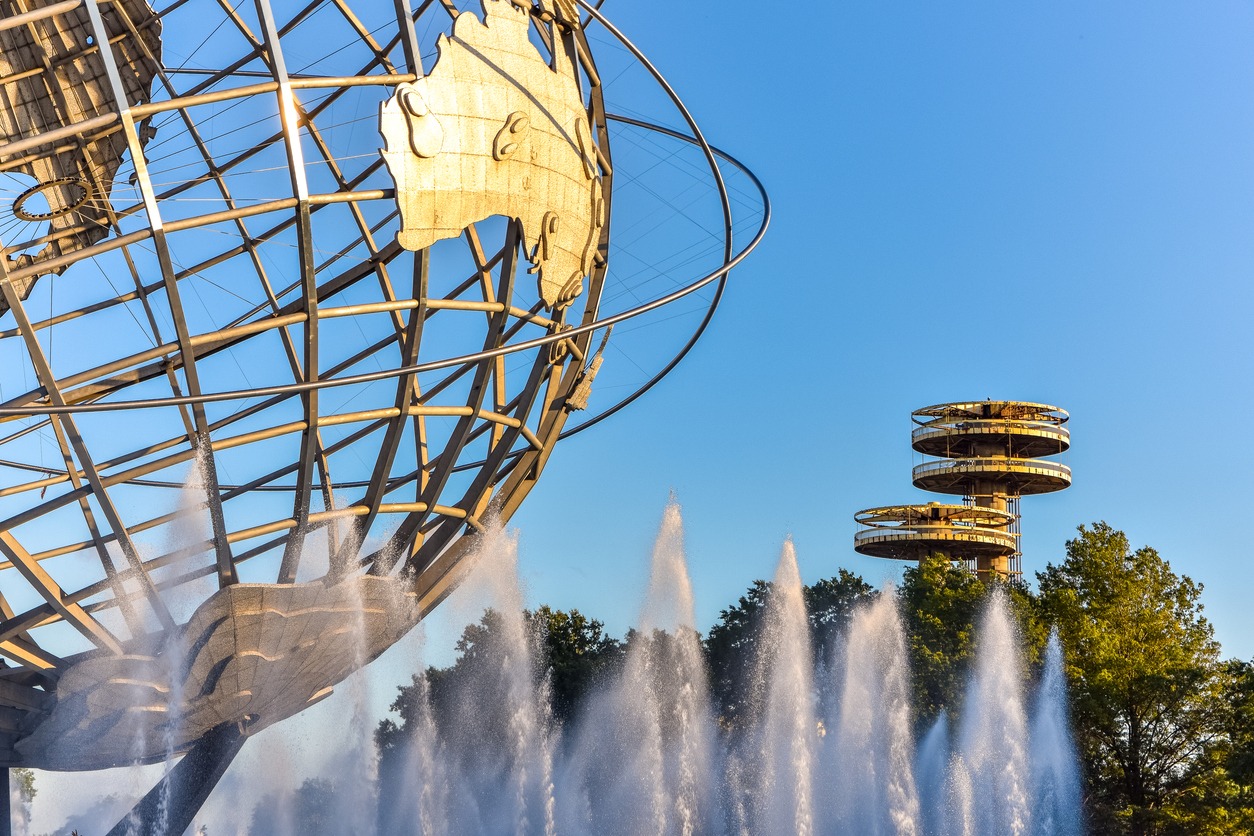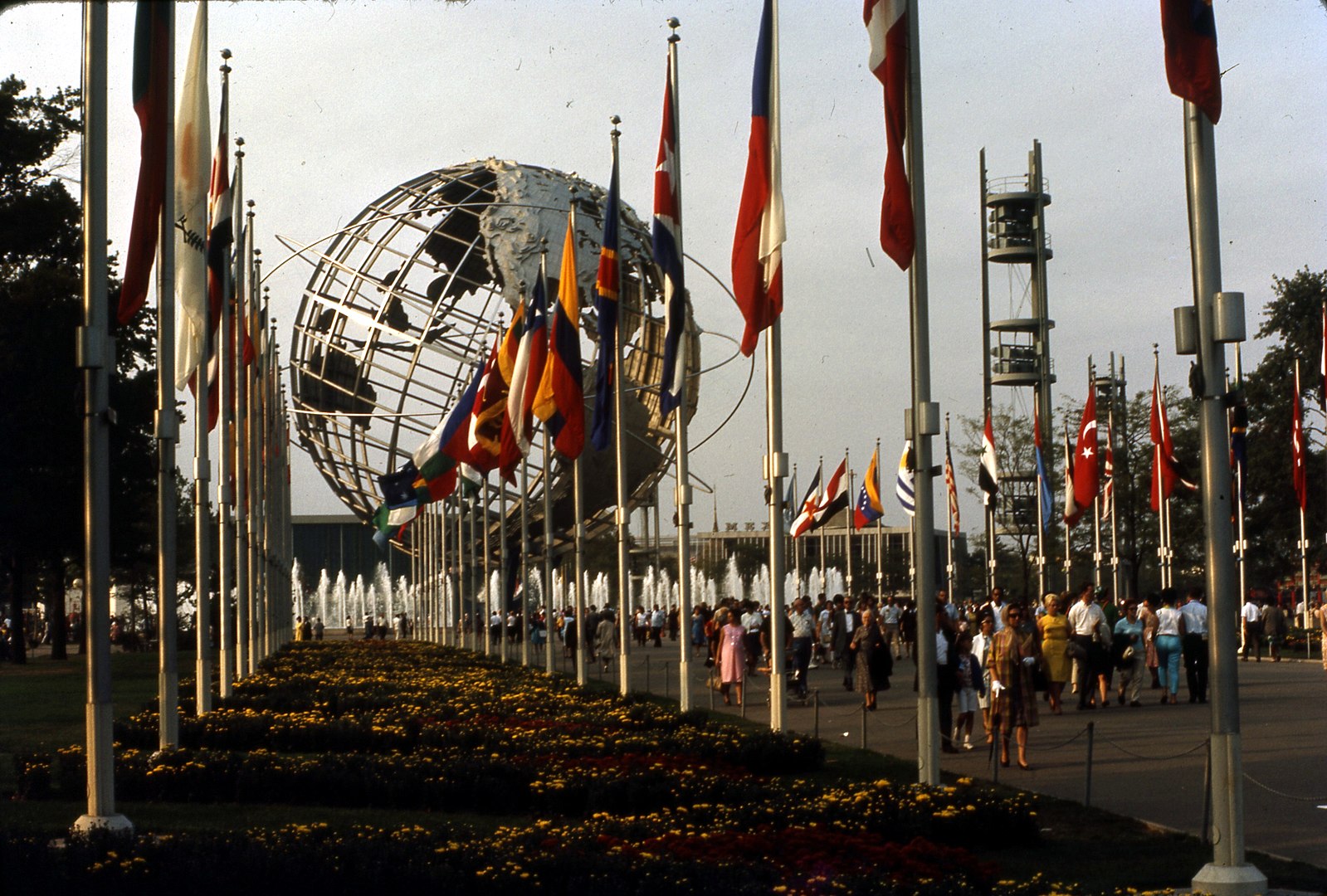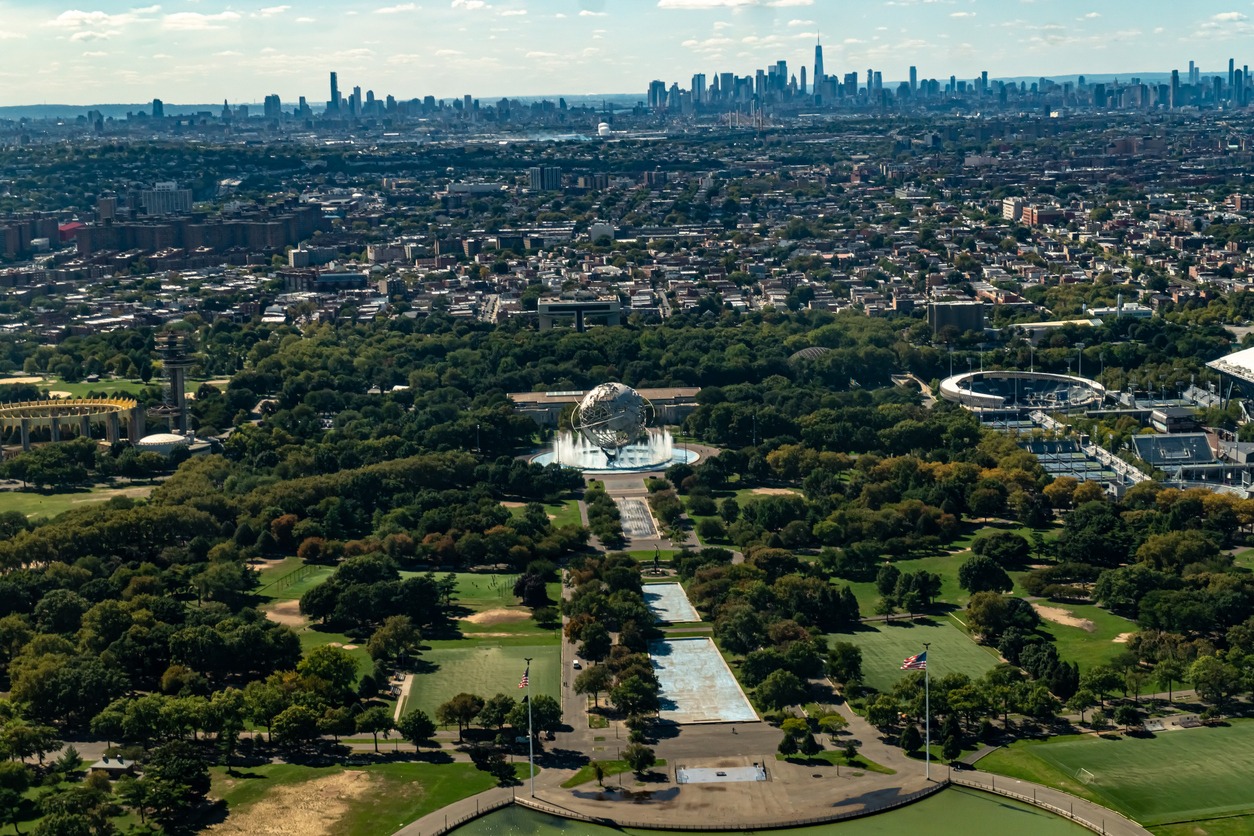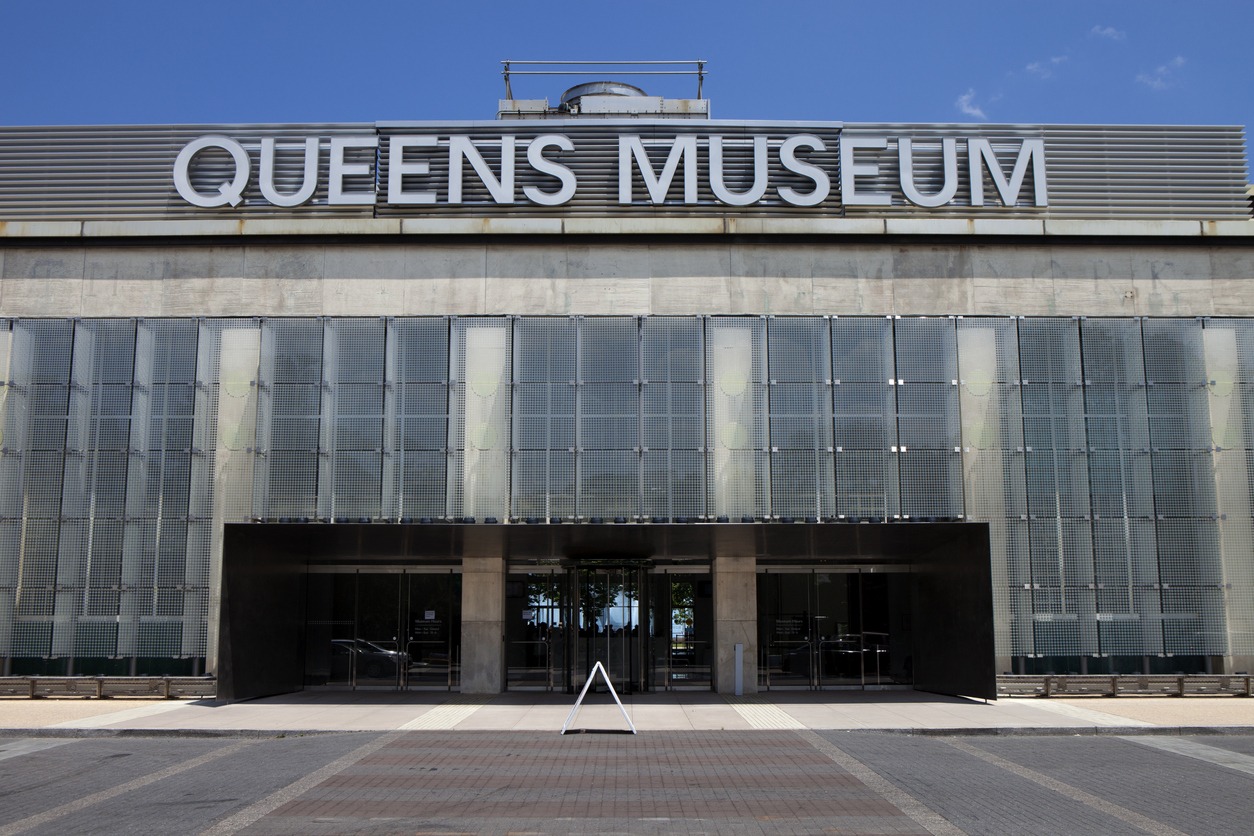The Flushing Meadows-Corona Park is a sprawling green oasis in Queens that is rich with history from the World’s Fairs. This park isn’t just about relaxation and sports; it’s a journey through the legacies of innovation and unity. With structures like the Unisphere, a giant globe that symbolizes world peace, and the remnants of pavilions, the park offers a glimpse into past dreams and achievements. It is a place where history meets the hustle and bustle of modern New York. As we explore, we’ll uncover how the World’s Fairs shaped this area and why it’s still relevant to locals and visitors alike. Join us as we delve into the legacy of the Queens’ World Fair history, exploring what makes this park a beloved landmark.
Foundations and Evolution of Flushing Meadows
The transformation of Flushing Meadows from a tidal marshland into a sprawling 1,255-acre park is a story of vision and ambition. Initially a desolate area used for ash dumping, the site was reimagined as a beacon of the future for the 1939/1940 New York World’s Fair. The fair’s theme, “Building the World of Tomorrow,” wasn’t just a slogan but a promise to showcase humanity’s potential for innovation and progress. This event sought to uplift a nation reeling from the Great Depression, focusing on the optimism of technological advancements, modernist architecture, and cultural exhibitions that portrayed an idealistic view of the future.
The park’s planning and construction were monumental tasks. Architects, engineers, and artists collaborated to turn what was once a wasteland into a symbol of hope and progress. The result was an array of futuristic structures, gardens, and pavilions that captured the imagination of people.
Furthermore, Flushing Meadows-Corona Park is intrinsically linked to the legacy of Queens’ World Fair history as it was the site of both the 1939/1940 and the 1964/1965 New York World’s Fairs. These events transformed the park into a showcase of international culture, technological innovation, and futuristic vision, leaving behind iconic structures. The park’s current form and its attractions are direct results of its World Fair history, making it a living monument to these large-scale, historic events that shaped not only the landscape but also the cultural and technological progress celebrated in Queens and the wider world.
The World’s Fair as a Cultural Phenomenon
The 1939/1940 World’s Fair showcased ingenuity and aspiration, featuring technological marvels that seemed like science fiction. One of the most significant introductions was television; a technology revolutionizing communication and entertainment. The View-Master, another innovation presented, offered people a new way to see the world in three dimensions from their homes.
Moreover, one of the most talked-about exhibits was General Motors’ Futurama, which envisioned a future of interconnected highways and cities, predicting the interstate highway system and influencing urban planning for decades to come. The fair wasn’t just about technology; it was about presenting a vision of the future that was optimistic, streamlined, and technology-driven.
The fair’s architecture, particularly the Trylon and Perisphere, became symbols of this futuristic vision. These structures embodied the fair’s theme and served as a backdrop for the exhibition’s most memorable moments. They were not just architectural feats but icons of a moment when the future was filled with endless possibilities.
The Legacy of the 1939/1940 World’s Fair
The legacy of the 1939/1940 World’s Fair extends beyond its technological and architectural contributions. It was a cultural moment that shaped America’s ideals of the future. The fair’s optimistic outlook and celebration of innovation resonated with a country looking for hope amidst economic despair. It served as a platform for America to assert its place as a leader in technology, culture, and ideas.
After the event, the fairgrounds continued to be essential for Queens and the broader New York City area. Many of the structures were repurposed or stood as monuments to this grand event, with Flushing Meadows continuing to evolve as a space for recreation, reflection, and community gatherings.
Advancing the Vision with the 1964 World’s Fair
The 1964/1965 World’s Fair, held at the same location, sought to advance the vision of its predecessor with the theme “Peace Through Understanding.” It aimed to promote a global perspective and unity, featuring pavilions from more than 80 nations. This fair continued the tradition of showcasing technological innovation and cultural exchange on a grand scale.
One of the most notable introductions was the Ford Mustang, a car that would become an icon of the American automotive industry. The Unisphere, a massive stainless-steel globe, was erected as the symbol of the fair, representing peace through global understanding. This structure remains one of the most recognizable landmarks of Flushing Meadows and a testament to the fair’s legacy.
Furthermore, Disney’s involvement brought a touch of magic to the fair, with attractions like “It’s a Small World” that would become beloved by generations. These exhibits provided entertainment and carried forward the fair’s theme of global community and shared future.
Post-Fair Legacies
After the World’s Fairs concluded, Flushing Meadows-Corona Park didn’t just return to its original state; it evolved, reflecting the changes and aspirations of the times. While many of the fair’s structures were dismantled, notable remnants stand to this day, serving as historical markers and attractions. The New York State Pavilion, though no longer in use, still captures the imagination with its futuristic design. The Unisphere, perhaps the most iconic leftover, continues to symbolize man’s aspirations for peace and unity.
The Queens Museum is another significant legacy. Once the New York City Pavilion during the 1939 fair, it has been repurposed to house various exhibits, including the “Panorama of the City of New York.” This scale model offers a detailed view of all five boroughs, exemplifying the fair’s commitment to innovation and education.
The park itself has undergone extensive redevelopment to serve the community’s needs, incorporating sporting facilities, cultural venues, and natural areas. These developments ensure that the park remains a vibrant, functional space while honoring its storied past. Each remaining structure and new addition tells part of the story of the World’s Fairs, reflecting the era’s optimism and looking forward to the future of Queens and New York City. As such, Flushing Meadows-Corona Park continues to be a living legacy of the World’s Fairs, inviting new generations to explore, learn, and imagine.
Flushing Meadows Today
Today, Flushing Meadows-Corona Park thrives as a crucial urban park, deeply woven into New York City’s community life. It provides a vast array of recreational and cultural amenities to the diverse populations that it serves. As the home of the USTA Billie Jean King National Tennis Center, it draws global attention every year during the US Open, showcasing top tennis talent and bringing together sports enthusiasts from around the world.
The Queens Museum, located within the park, is a beacon of art and history, offering a variety of exhibits, including the famous “Panorama of the City of New York.” It continues to engage and educate visitors with its wide range of artistic and cultural exhibitions, acting as a cultural center in the park. Moreover, the New York Hall of Science, another legacy of the World’s Fair, remains an interactive science museum, providing educational and fun scientific exhibits that engage children and adults alike. Its continued commitment to making science accessible and enjoyable makes it a staple in the educational landscape of the park.
Adjacent to these cultural institutions is the Queens Zoo, a conservation-minded establishment that brings the animal kingdom closer to urban visitors. It provides educational programming and intimate encounters with wildlife, emphasizing conservation and the importance of biodiversity. Beyond these institutions, Flushing Meadows is replete with recreational facilities. It boasts athletic fields, picnic areas, playgrounds, and the scenic Meadow Lake, the largest lake in New York City parks. These areas host a variety of sports and leisure activities, serving as a communal ground for relaxation, exercise, and social interaction.
The park also preserves historical monuments from its days as the World’s Fair site, such as the iconic Unisphere and the New York State Pavilion. These structures stand as tangible links to the past, embodying the park’s historical significance and the visionary spirit of the fairs.
Flushing Meadows-Corona Park, thus, continues to be a vibrant and multifaceted space. It honors its rich history while providing essential green space and cultural resources, reflecting the dynamic and diverse nature of Queens and offering a microcosm of urban vitality and communal harmony.
Exploring the Wonders of Flushing Meadows-Corona Park
Flushing Meadows-Corona Park is more than just a park; it’s a microcosm of cultural, historical, and recreational activities. Whether you’re visiting for the first time or rediscovering it, there’s always something new to explore and appreciate in this vibrant and storied urban oasis. Here are some of the park’s hidden gems:
1. The Time Capsules: The 1939 and 1964 World’s Fairs each buried a time capsule at Flushing Meadows, meant to be opened 5,000 years later. These capsules, known as the “Crypt of Civilization,” are filled with everyday items, written messages, and predictions of the future, capturing the essence of their respective eras. The 1939 capsule includes texts like the Bible, a Sears Roebuck catalog, and a newsreel. The 1964 capsule added microfilm, a bikini, and seeds of common food crops. Located near the Westinghouse pavilion site, they symbolize hope for the future and a fascinating snapshot of historical optimism.
2. The Model Boat Regatta: Meadow Lake is the largest lake in New York City parks and a gathering spot for model boat enthusiasts. On weekends and sunny days, you might find individuals or groups navigating miniature sailboats and motorboats across the water. This hobby, which combines craftsmanship with leisure, creates a serene and almost whimsical atmosphere. The regatta is a unique and charming aspect of the park, providing a delightful contrast to the bustling city life just beyond.
3. The Playground for All Children: As the first playground in America designed for inclusivity, this playground set a precedent for accessible play spaces nationwide. It includes wide ramps for wheelchair access, adaptive swings, and interactive play equipment that accommodates children with various physical abilities. The playground is more than just a play area; it’s a community statement promoting inclusivity and equality. It represents the park’s commitment to serving all visitors, making it a special place for families and children to gather, learn, and play together.
4. The Rocket Thrower: Created by Donald De Lue for the 1964 World’s Fair, The Rocket Thrower is a magnificent sculpture located in the park’s Avenue of the Planets. It depicts a muscular figure, soaring skyward as he throws a rocket into space, embodying humanity’s ambitious dreams to conquer the stars. The sculpture, standing 43 feet tall, reflects the era’s fascination with space exploration and serves as a powerful representation of mankind’s ceaseless pursuit of knowledge and discovery. Surrounded by greenery, this lesser-known piece offers a moment of reflection on the human spirit’s boundless aspiration.
5. The Pat Dolan Trail: Dedicated to a local conservationist, this trail wraps around Willow Lake, offering a peaceful respite from urban life. It’s a favorite among bird watchers, nature enthusiasts, and those seeking a quiet stroll. The trail is part of the larger QueensWay project, which aims to connect more green spaces and communities. Along the way, visitors can enjoy diverse flora and fauna, scenic views of the lake, and perhaps a moment of solitude. The Pat Dolan Trail is a testament to the community’s efforts to preserve and enjoy nature in the midst of the city.
Each of these hidden gems contributes to the unique tapestry of Flushing Meadows-Corona Park, offering visitors a deeper and more personal experience of the park’s history, culture, and natural beauty. Whether you’re seeking inspiration from art, a glimpse into the past, or a quiet moment in nature, these lesser-known attractions provide a rich, layered exploration of one of New York’s most beloved parks.
If you want to learn more about Brooklyn’s Historical places, visit Exploring Sunset Park – A Brooklyn Melting Pot with Manhattan Views.
Conclusion
Flushing Meadows and the legacy of Queens’ World Fair history represent the ambition, innovation, and cultural aspirations of 20th-century America. They offer a window into the past and a vision for the future, reminding us of the power of human creativity and collaboration. As a living legacy, Flushing Meadows continues to evolve, embodying the dreams and realities of the diverse communities it serves.




